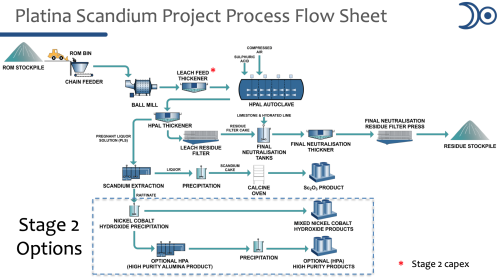Energy & Critical Metals
Rio Tinto acquires high-grade scandium project in Australia
Rio Tinto has entered into a binding agreement to acquire the Platina Scandium Project (PSP), a high-grade scandium resource in New South Wales, from Platina…

Rio Tinto has entered into a binding agreement to acquire the Platina Scandium Project (PSP), a high-grade scandium resource in New South Wales, from Platina Resources Limited for $14 million.
The project, near Condobolin in central New South Wales, contains a long life, high-grade scalable resource that could produce up to 40 tonnes per annum of scandium oxide, for an estimated period of 30 years. A 2018 Definitive Feasibility Study (DFS) confirmed the technical and financial viability of constructing a simple, low-strip ratio, open-cut mining operation and processing facility.
PSP is a laterite ore deposit; two-thirds of world nickel production comes from similar laterites. PSP envisions using a conventional High-Pressure Acid Leach (HPAL) process route. From a 5.4wt bulk sample pilot tested, the company produced 99.99% Sc2O3 (scandium oxide).
Rio Tinto currently produces scandium oxide from titanium dioxide production waste streams at Sorel-Tracy in Quebec. Once operational, the Platina Scandium Project would enable Rio Tinto to more than double its annual scandium production.
This acquisition aligns with Rio Tinto’s strategic goal to grow in materials essential for the low-carbon transition.
Scandium is a rare, versatile and useful mineral for the green economy and energy transition. It is considered a critical mineral by the United States, Canada, Australia and many other countries.
Scandium is one of the most effective elements able to strengthen aluminum, while also offering improved flexibility and resistance to heat and corrosion. As a result, it is used to produce high-performance aluminum alloys for applications that need to be light, strong and heat resistant, including in aerospace, automotive, heat exchangers, sporting goods, 3D printing and energy transmission applications.
Scandium oxide is also used to improve the performance of solid oxide fuel cells used as a green power source for buildings, medical facilities and data processing centres, as well as in niche products such as lasers and lighting.
With its aluminum business, Rio Tinto is also positioned to produce more high-performance aluminum-scandium alloys. The transaction is expected to be completed in the first half of 2023.

Uranium Exploration Company Announces Additional Staking in the Athabasca Basin
Source: Streetwise Reports 12/22/2023
Skyharbour Resources Ltd. announced an update from its Canada-based Falcon Project along with additional…
Tesla Launches New Mega Factory Project In Shanghai, Designed To Manufacture 10,000 Megapacks Per Year
Tesla Launches New Mega Factory Project In Shanghai, Designed To Manufacture 10,000 Megapacks Per Year
Tesla has launched a new mega factory…
Giving thanks and taking stock after “a remarkable year”
An end-of-year thank you to our readers, industry colleagues and advertisers before Electric Autonomy breaks from publishing until Jan. 2
The post Giving…

















